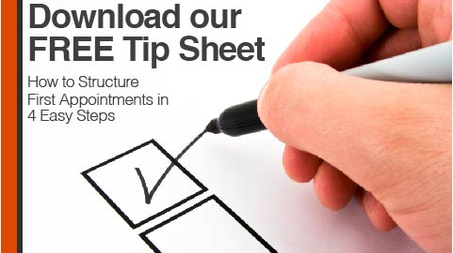If This, Then What? 10 Insightful Sales Filters to Fill Your Pipeline with More First Appointments
A healthy sales pipeline means you have the right balance of opportunities at every stage.
A sales pipeline stage represents each step a prospect takes through your sales process, from becoming a lead to becoming a customer.
But it all starts with a first appointment. It is the foundation to building a solid pipeline.

Every organization may define their stages a little bit differently, but from a high-level the first appointment stage holds the list of people you have a scheduled first appointment with over the next four-weeks.
And when I say ‘scheduled’ I don’t mean you loosely agreed to call them back in the next few weeks. I mean your prospect has accepted and confirmed the meeting on their calendar and is expecting your call on that specific day and time.
One of the most important conversations you have with a prospect is during the first appointment.
This is when you discover whether the prospect is a good fit for your product or service and you can move forward with the relationship, or if it’s time to go separate ways.
A lot of times it’s not immediately obvious, which makes this part of the sales process so crucial.
The first appointment is your opportunity to qualify the lead and then identify an appropriate next step. And since you know that some prospects will move forward while others don’t, generating the right number of first appointments is the key to building and maintaining a pipeline that delivers results.
For the pipeline management to work effectively, you can’t run out of prospects. To do that, you can’t run out of first appointments. Therefore, we need to redefine time management for salespeople: to “finding time to prospect every day, even when you are busy selling.”
Here are 10 if-then statements to help you manage your time and emphasize the importance of consistently filling your pipeline with first appointments:
- If you are closing sales every month and want to avoid a slow month, then remember: scheduling a first appointment is the only way to replace a sale and a lost opportunity.
- If you want to increase your deal flow per month, then remember: increasing the number of first appointments in your pipeline will shorten the time between sales.
- If you don’t want a gap between closing one sale and closing the next, then begin replacing opportunities 4 to 8 weeks before you lose them.
- If you need to decide how safe or strong to play a meeting, then look to your calendar for courage. First appointments are like trains in the distance delivering promise; collectively, they give salespeople their position of strength.
- If your calendar has a lot of first appointments, then make sure you take the time to qualify each appointment so you only continue having appointments with the opportunities which are most likely to close.
- If you need to get more prospects in your pipeline, then focus on the little wins. This can include scheduling meetings to maximize fact-finding and relationship building because you need to learn about your prospect, their business, their team, and their goals.
- If you want to increase your average deal size, then complete the “Biggest Possible Deal” exercise before every first appointment in order to properly evaluate the potential opportunity and identify the right starting point to collect the largest portion of budget.
- If you conclude a first appointment with a promise to send a proposal, then you are attempting to actively shorten the sales cycle. But, be careful…
- If you shorten the sales cycle too much by abbreviating the time between first conversation and proposal, then your proposal may reach them too soon -- before they are ready to make a decision.
- If you want to uncover what the prospect is really thinking, then don’t assume they only know what you tell them. What have they learned on their own? What is their history with similar products and services? Be sure to ask the right questions.
As you apply these filters, also consider how you prepare for first appointments by looking at these five things:
- Lead Source: Consider where the lead came from. Do you know the conversion rate for these types of leads? What are leads from this source typically looking for? The more you know about where the lead came from and similar success stories, the better prepared you will be. Understanding the path to becoming a lead will also provide you with insight into the type of issues or challenges the lead is looking to solve and what buyer persona they match.
- Engagement Points: You will probably need to work with your marketing team on this one, but if the lead came through your website or other digital channel then you should have a few data points that provide more insight on the engagement points that lead to becoming a lead. For instance, what content did they look at? Were they on one of your social media channels? Are they signed up for your newsletter? Whatever you can learn about the lead will help you personalize your first appointment meeting with them.
- Buyer Persona: In addition to understanding the lead source, you need to have a crystal-clear picture of your buyer persona(s). Sure, there may be exceptions to the rule but more often than not the leads that don’t align with one of your buyer personas will not be a good fit, they will likely string you along, and ultimately never end up buying your product or service. So, look for signals that tell you the lead aligns with one of your buyer personas. Armed with this information, you will be prepared to ask the right questions and deliver a compelling story about why they should work with you.
- Qualifying Questions: Every company has a different process or framework for qualifying sales opportunities, but at a minimum, the tried and true framework BANT (Budget, Authority, Need, Timeline) covers the broad spectrum of qualification. BANT seeks to uncover the following four pieces of information:
- Budget: Is the prospect capable of buying?
- Authority: Does your contact have adequate authority to sign off on a purchase?
- Need: Does the prospect have a business pain you can solve?
- Timeline: When is the prospect planning to buy?
- Next Steps: What next step will you ask for after the first appointment? In terms of gathering the information you need you may have only scratched the surface. That’s okay. The purpose of this meeting is to really qualify the opportunity and make sure the lead is a good fit. If that’s the case, then you should have some ideas of what next step you will ask for. Perhaps that means setting up a demo or another meeting with other key stakeholders who are part of the decision-making process. Either way, you should be prepared to lead the conversation and suggest a next step.
The first appointment is where every sales opportunity begins and ends.
If you want to avoid the ups and downs of selling, then pay attention to your first appointment stage. The more you’re able to fill that stage with opportunities, the better your deal flow will be.
*Originally published in July 2016, updated in September 2019.
About Steve Bookbinder
Steve Bookbinder is the CEO and sales expert at DMTraining. He has delivered more than 5,000 workshops and speeches to clients all over the world and has trained, coached, and managed more than 50,000 salespeople and managers. Steve continuously refreshes his training content to reflect his latest first-hand observations of salespeople across industries and regions. Through him, participants in his workshops and coaching sessions learn the best practices of today’s most successful sellers and managers across industries. Steve understands that sales is a competitive game. To outperform competitors and our own personal best results, we need to out-prospect, out-qualify, out-present and out-negotiate everyone else, not merely know how to sell. Through his specialty programs in Pipeline Management, Personal Marketing, Great First Meetings, 2nd-level Questioning, Sales Negotiating, and Sales Coaching, Steve trains sales teams to master the skills they need to overcome the challenges they face in today’s world… and keep improving results year over year.





